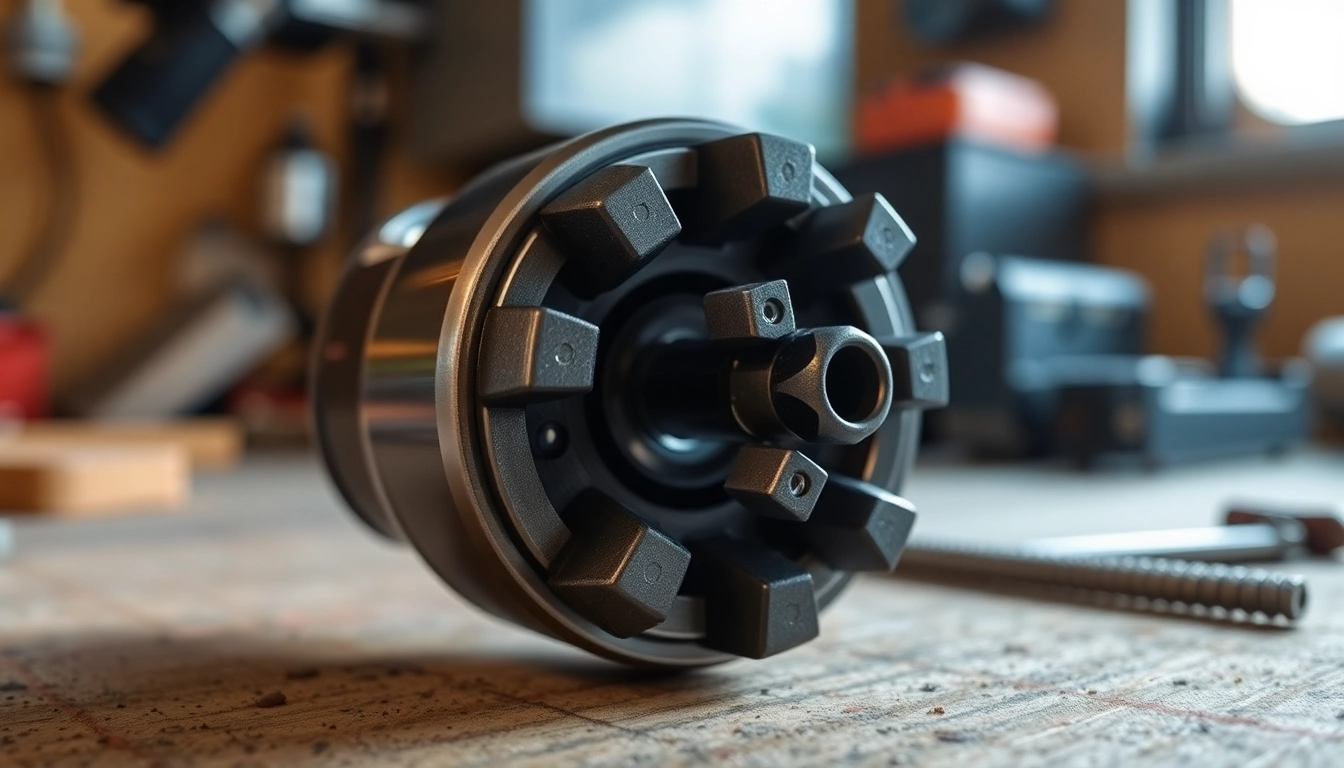Understanding Drill Chucks: Types and Functions
When it comes to using power tools, few components are as critical as the drill chuck. This unassuming piece of machinery is essential for holding the drill bit securely in place, thereby ensuring precision in drilling operations. Understanding the various types of drill chucks and their specific functions can significantly enhance your tool’s performance and reliability. In this discussion, we will delve deeper into the types of drill chucks, how they function, and the applications where each excels.
1.1 Keyed vs. Keyless Drill Chucks
Drill chucks can primarily be categorized into two main types: keyed and keyless. Each type caters to different user preferences and operational needs.
Keyed Drill Chucks
A keyed drill chuck requires a specific key to tighten or loosen the jaws that hold the drill bit. This design allows for a very secure grip on the bit, ensuring that it does not slip during use. This is particularly important when dealing with tougher materials or when high torque is required. Keyed chucks are commonly found in heavy-duty power tools, such as drill presses.
Keyless Drill Chucks
On the other hand, keyless drill chucks offer convenience and speed. Users can easily adjust the chuck by hand, without the need for an extra tool. This feature is advantageous for quick bit changes and for operations requiring frequent bit swaps. However, keyless chucks typically do not provide the same level of grip strength as their keyed counterparts, making them less suitable for high-torque applications.
1.2 Hybrid Drill Chucks Explained
Hybrid drill chucks combine features from both keyed and keyless designs. They typically have a mechanism that allows for quick adjustments while providing additional grip security. This hybrid nature makes them a versatile choice, appealing to users who want the best of both worlds. Hybrid chucks can be a great option for users who frequently switch between tasks that require high precision and those that benefit from speed and convenience.
1.3 Application Areas for Different Chucks
Understanding the applications for different types of drill chucks is crucial for maximizing tool efficiency. Keyed chucks are ideal for applications requiring consistent precision, such as woodworking or metalworking, where bit slippage can result in inaccuracies. Keyless chucks find their use in scenarios where speed is of the essence, such as assembling furniture or general household repairs. Hybrid chucks offer flexibility, adapting well to varied tasks, making them popular among DIY enthusiasts and professional craftsmen alike.
Choosing the Right Drill Chuck for Your Needs
Selecting the right drill chuck is paramount for enhancing tool performance and achieving desired results. Various factors influence this decision, including the type of work you do, the tools you have, and your personal preferences.
2.1 Factors to Consider When Selecting a Drill Chuck
Several factors should guide your choice of drill chuck:
- Compatibility: Ensure that the chuck fits your drill’s spindle size. Most drills have either a 3/8”-24 or 1/2”-20 spindle, so compatibility is essential.
- Bit Size: Consider the maximum bit size your projects require. Different chucks accommodate various sizes, so choose one that matches your needs.
- Material: Depending on your intended use, select a chuck made from sturdy materials that can withstand wear and tear.
- Ease of Use: Decide whether you prefer a keyed or keyless chuck based on your work habits. If you often switch between bits, a keyless chuck might be more suitable.
2.2 Common Brands and Their Offerings
Several brands are renowned for their high-quality drill chucks. Some of the notable names include:
- Jacobs: A pioneer in drill chuck technology, Jacobs is known for its durability and precision. Their products are widely used in industrial settings.
- Röhm: This brand offers a wide range of chucks suitable for both professionals and hobbyists. Their chuck configurator tool helps users find the right fit based on their specific needs.
- Albrecht: Recognized for precision engineering, Albrecht drill chucks are often the preferred choice for applications where accuracy is paramount.
2.3 Compatibility with Popular Drill Models
Before purchasing a drill chuck, it’s essential to ensure its compatibility with the drill model you own. Popular drill models such as Dewalt, Makita, and Bosch each have specific chuck requirements based on their design. Always check manufacturer specifications or consult a tool expert to determine the best fit for your drill and the types of tasks you intend to perform.
Installation and Maintenance of Drill Chucks
Proper installation and maintenance of drill chucks are essential for ensuring their longevity and optimal performance. This section will guide you through the steps needed to install your chuck correctly and how to maintain it over time.
3.1 Step-by-Step Installation Guide
Installing a drill chuck can vary depending on the type, but here is a general guide:
- Remove the Old Chuck: If you’re replacing an existing chuck, begin by loosening it. For keyed chucks, use the key to open the jaws and gently pull the chuck off. In the case of keyless chucks, turn the outer collar in the opposite direction to remove.
- Prepare the New Chuck: Ensure that the new chuck is clean and free from debris that could affect its performance.
- Install the Chuck: Align the chuck with the drill spindle. For keyed chucks, tighten it securely using the key in a clockwise motion. For keyless chucks, twist the outer casing until it is firmly attached.
- Test the Fit: Insert a drill bit and tighten the chuck to check if it holds the bit securely. Double-check that the bits do not wobble during rotation.
3.2 Regular Maintenance Tips for Longevity
Maintaining your drill chuck is once again pivotal for ensuring it delivers reliable performance over time. Consider the following maintenance tips:
- Clean Regularly: After each use, clean the chuck to remove dust and debris that may affect performance.
- Lubrication: Apply a few drops of oil to the chuck mechanism occasionally to keep it functioning smoothly.
- Inspect for Wear: Regularly check for signs of wear, cracks, or damage. If any issues are detected, replace the chuck immediately to avoid safety hazards.
3.3 Troubleshooting Common Issues with Drill Chucks
Users may encounter some common issues with drill chucks, such as:
- Slipping Bit: This could indicate improper alignment or a worn-out chuck. Ensure the chuck is tightened properly, and if problems persist, consider a replacement.
- Difficulty Tightening: If the chuck is hard to tighten or loosen, it may need lubrication or cleaning.
- Jaw Damage: Inspect the jaws regularly for any nicks or damage, as this can affect their ability to grip the bit securely.
Performance Metrics: Evaluating Drill Chuck Effectiveness
Evaluating the performance of a drill chuck is essential to assess its effectiveness for your specific needs. Several metrics can help you determine whether a particular chuck meets your expectations.
4.1 Measuring Precision and Accuracy
Precision in drilling is often dictated by the quality of the chuck. High-quality chucks will provide minimal bit wobble during operation, allowing for cleaner holes and better finishing. Users can conduct tests by drilling pilot holes and measuring their accuracy. Additionally, looking at industry certifications and user reviews can provide insights into a chuck’s precision.
4.2 Comparing Torque and Handling Efficiency
Torque is another critical factor affecting a drill chuck’s performance. This measure reflects how well the chuck can hold a drill bit under load. Users should evaluate chucks based on torque ratings provided by manufacturers and performance reviews. Efficient handling includes easy adjustments and bit changes, especially for operational tasks requiring rapid transitions.
4.3 Customer Reviews: What Users Say About Their Choices
User feedback is invaluable when assessing drill chucks. Platforms such as Amazon and dedicated tool review sites often feature detailed customer experiences that can highlight strengths and weaknesses. It’s wise to pay attention to common themes in customer reviews regarding durability, performance reliability, and ease of use.
Best Practices for Using Drill Chucks Safely
Safety should always be a priority when handling power tools. Following best practices can prevent accidents and improve user experience when using drill chucks.
5.1 Safety Guidelines for Handling Power Tools
Always adhere to general safety guidelines when working with power tools:
- Wear appropriate personal protective equipment (PPE), including safety goggles and gloves.
- Ensure your workspace is clean and well-lit to avoid accidents.
- Familiarize yourself with the tool’s instruction manual before use.
5.2 Ensuring Proper Fit and Torque Settings
Before starting any drilling project, it is essential to ensure that the drill chuck is correctly fitted and secure. Adjust the torque settings according to the material being drilled to prevent bit slippage or breakage.
5.3 Post-Use Care and Storage Tips
After using the drill, clean the chuck and store it properly to prevent damage. Avoid exposing your drill chuck to extreme temperatures or moisture, as these elements can compromise its integrity over time. Consider using a dedicated storage container for the chuck and drill bits to keep them organized and protected.



